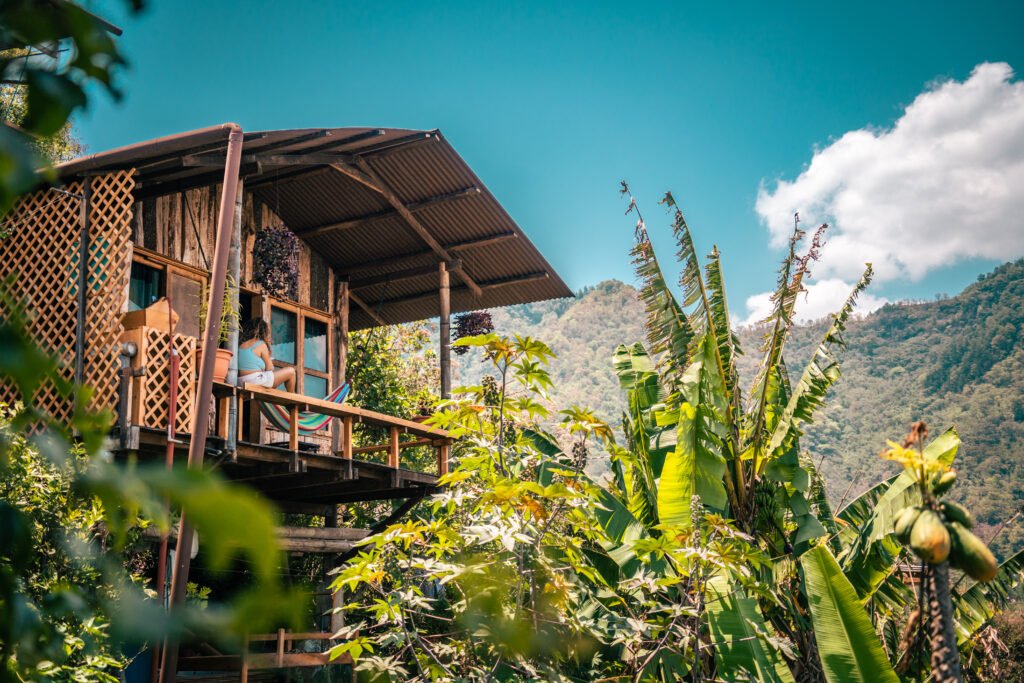Discover the Tranquility of the Top 5 Yoga Eco-Village Experience

Embracing Holistic Wellness at a Yoga Eco-Village Experience
The embrace of holistic wellness within the confines of a Yoga Eco-Village experience is a transformative experience that transcends the typical escape from daily life. It invites visitors to delve into a profound awakening that harmonizes the mind, body, and spirit. Here, the ancient art of yoga is interwoven with the raw beauty of nature to curate a sanctuary where inner peace is not only sought after but palpably experienced.
The Harmony of Nature with Yoga Practice
The dawn chorus of birds heralds in the new day, while a gentle breeze carries away the last vestiges of yesterday’s worries. Surrounded by the natural world, yoga practitioners find their movements echoing the organic patterns of life around them. Each asana becomes a silent conversation with nature, enhancing the spiritual connection and fostering a deep, grounding presence within the sanctuary of an eco-village.
Revitalizing Your Health in a Sustainable Environment
Nestled amongst the elements, the yoga eco-village experience does not only provide a stage for yoga but also underscores a commitment to health and sustainability. Here, every breath of air is a testament to purity, every drop of water a symbol of clarity. Yoga becomes more than exercise; it evolves into a celebration of life, each pose a note in the symphony of self-restoration, supported by an environment that thrives on clean living and ecological harmony.
Eco-Friendly Practices for Sustainable Living
The implementation of eco-friendly practices is foundational to the ethos of a Yoga Eco-Village experience. In these havens of sustainability, visitors are introduced to a way of life that actively reduces the human carbon footprint, conserves natural resources, and promotes the welfare of our ecosystem. These practices are seamlessly blended with the yoga lifestyle, encouraging practitioners to live in a way that reflects respect for our delicate Earth.
Integrating Green Living with Yoga Ethics
The eightfold path of yoga incorporates principles such as non-harming (Ahimsa) and self-discipline (Tapas) that naturally align with ecological stewardship. In an eco-village, these principles come alive through the adoption of renewable energy, water conservation, and waste reduction. As such, every action becomes an act of mindfulness, reflecting the inner growth that is cultivated on the mat.
Building Eco-friendly Communities Through Yoga
The fabric of a yoga eco-village experience is woven with the threads of community and fellowship. It is a place where the values of yoga create a strong collective ethos focused on environmental respect. Inhabitants and visitors alike are melded into a cohesive entity, striving together to maintain ecological balance and foster a spirit of cooperation and shared purpose.
Benefits of Choosing a Yoga Eco-Village Experience for you
The decision to partake in a yoga retreat at a yoga eco-village experience is an invitation to a holistic overhaul of the self. Here, the healing power of yoga is magnified by the purity of natural surroundings and ecologically conscious living. A retreat like this doesn’t just offer respite but reconnection with the deeper rhythms of nature, profoundly influencing physical health, mental clarity, and spiritual growth.
Connecting with Like-Minded Individuals
The yoga eco-village experience attracts those whose hearts resonate with the same frequency of care for the self, community, and planet. Each person you meet reflects a facet of your own intent, providing fruitful ground for meaningful connections that often blossom into lifelong friendships and networks of support.
A Comprehensive Approach to Mindful Living
Within the boundaries of this green haven, the practice of yoga becomes a living philosophy. Every activity, from the first morning stretch to the last flicker of candlelight at night, is steeped in mindfulness. The lessons learned here shape a comprehensive lifestyle, one where peace and mindfulness percolate through every pore of existence.
Organic Food and Nutrition: Fueling Your Yoga Journey
A cornerstone of the Yoga Eco-Village experience is the commitment to organic food and superior nutrition. These villages serve as purveyors of a diet that supports and amplifies the yogic path. Every meal is an opportunity to partake in nutritionally rich, chemical-free produce that fuels the body for a heightened yoga practice and nourishes the soul.
The Importance of Diet in Enhancing Yoga Practices
The correlation between what we consume and how we perform in yoga is undeniable. Fresh, organic fare devoid of artificial additives complements the clean, vibrant energy that yoga cultivates. Each meal becomes a conscious act of nourishing the body intelligently, with ingredients that are selected for both their flavor and their life-enhancing properties.
From Earth to Table: Experience Organic Meals in a Yoga Eco-Village Experience
The journey of food in a yoga eco-village experience epitomizes the cycle of life. From the gentle tending of the earth, witnessing the sprouting of seeds, to the harvest that brings forth bountiful produce, each step reinforces the connection between man and nature. Dining in this context is an experience that engages all the senses, transforming eating from a mere necessity to a joyful celebration of life’s natural abundance.

Architectural Elegance: Yoga Eco-Village Experience Designed for Yogis
In a Yoga Eco-Village experience, the architectural design is an embodiment of elegance and mindfulness, crafted to align with the natural surroundings and meet the needs of those on a yogic path. The intention is to create spaces that facilitate inner peace and self-discovery through sustainable building techniques that honor the environment and provide a sanctuary for meditation and yoga.
Sustainable Building Techniques for Yoga Facilities
Using locally-sourced materials and leaning on green building technologies, the structures within the yoga eco-village experience align with its sustainable ethos. Solar panels, rainwater harvesting systems, and passive cooling methods are delicately integrated to minimize the environmental footprint while maximizing functionality.
Living Spaces that Complement Your Spiritual Path
The living spaces here aim to be extensions of the yoga practice itself – serene, minimalist, and harmonious. They are designed to echo the yogic principle of simplicity, creating an environment free of clutter and distractions, where one can focus on the essence of life and the pursuit of a meaningful connection with the inner self.
FAQ: Questions and Answers of yoga eco-village experience
What are the benefits of an eco village?
The benefits of an eco village are numerous and can significantly contribute to sustainable living and community well-being. Eco villages are designed with the intention of minimizing environmental impact while providing a high quality of life for their residents. They often incorporate renewable energy sources, such as solar or wind power, to meet their energy needs, reducing reliance on fossil fuels and lowering carbon footprints. Moreover, eco villages promote the use of organic farming and permaculture principles, leading to the production of healthy, local food, and the preservation of biodiversity. Water conservation is also a key aspect, with many eco villages implementing rainwater harvesting and graywater recycling systems.
Community living in eco villages fosters a sense of belonging and shared purpose, enhancing social connections and support networks. These intentional communities are built on the principles of cooperation, equality, and mutual respect, providing a space for communal activities and collaborative decision-making. By focusing on sustainable and ethical living practices, eco villages serve as living laboratories for experimenting with and demonstrating alternative ways of living that may be less harmful to the planet and more fulfilling for individuals and communities.
How do you make a yoga retreat?
Creating a yoga retreat involves careful planning and consideration of various elements to provide a serene and transformative experience for participants. Firstly, deciding on a peaceful and conducive location is crucial, whether it’s a secluded natural setting or a tranquil space in a more populated area. The venue should offer a calm atmosphere suitable for yoga and meditation. Next, planning the schedule is essential, balancing structured activities like yoga classes, meditation sessions, and workshops with ample free time for relaxation and reflection.
Recruiting qualified and experienced instructors is important to ensure that participants receive proper guidance and support during their practice. Another aspect to consider is the provision of nutritious and wholesome meals that align with the health and wellness goals of the retreat. Offering additional services such as massage, counseling, or nature excursions can enrich the retreat experience. Lastly, promoting the retreat through social media, yoga networks, and wellness communities will help attract the right audience. Attention to detail, hospitality, and a nurturing environment are key to a successful yoga retreat.
What is permaculture and how does it benefit our environment?
Permaculture is an ecological design philosophy that aims to create sustainable and self-sufficient agricultural systems. It is based on the principles of working with, rather than against, nature, and observing the patterns and features observed in natural ecosystems. Permaculture encompasses a range of disciplines such as organic farming, agroforestry, and sustainable construction, and integrates land, resources, people, and the environment through mutually beneficial synergies.
The benefits of permaculture to our environment are numerous. It helps in building healthy soil, increasing biodiversity, conserving water, and reducing waste by mimicking the no-waste cycles of nature. Permaculture designs often incorporate water-saving features like swales and rain gardens, use companion planting to enhance soil health, and promote the recycling of organic material through composting. By adopting these principles, permaculture provides a viable blueprint for sustaining our environment in a way that can be both productive for humans and beneficial for the earth.
Why is community-built housing important for sustainable development?
Community-built housing plays a pivotal role in sustainable development by fostering collaborative efforts in the creation of affordable, eco-friendly living spaces. Such projects emphasize the involvement of the community members in the planning, design, and construction processes, leading to housing solutions that are closely tailored to the needs and desires of the locals. This inclusive approach can also promote social cohesion and provide educational opportunities in sustainable building practices.
From an environmental standpoint, community-built housing often leverages local, sustainable materials, and green building standards to minimize the ecological footprint. It cultivates a sense of ownership and accountability among residents, encouraging them to maintain and improve their living conditions responsibly. Community-built housing can also act as a catalyst for wider adoption of sustainable practices within the community, ranging from energy conservation to waste reduction, which are essential for meeting the long-term objectives of sustainable development.
What principles should a green building follow to be truly sustainable?
A green building should adhere to key principles to be truly sustainable, such as energy efficiency, water conservation, and sustainable material usage. It should be designed to reduce overall energy consumption by optimizing insulation, utilizing passive solar design, and incorporating renewable energy sources. Water-saving fixtures, rainwater harvesting systems, and wastewater treatment are vital for reducing water usage. The building should also make use of non-toxic, recycled, or sustainably-sourced materials. Indoor environmental quality is important, ensuring adequate ventilation and daylight to create a healthy, comfortable space for occupants. Finally, the building should be designed with its lifecycle in mind, allowing for easy maintenance, adaptability, and ultimately, recyclability, to reduce waste and environmental impact.
How can renewable energy be integrated into urban settings?
Summary of yoga eco-village experience





